CHAPTER XIX
He was "The
ancient Egyptian word for the personal pronoun 'I' was anuk,"
said the Tracer placidly. "The phonetic for a was the hieroglyph

a reed; for n the water symbol

for u the symbols

for k

Therefore this hieroglyphic inscription
begins with the personal pronoun
or I. That
is very easy, of course.
"Now,
the most ancient of Egyptian inscriptions read vertically in columns;
there are only two columns in this papyrus, so we'll try it vertically
and pass downward to the next symbol, which is inclosed in a sort
of frame or cartouch. That immediately signifies that royalty is
mentioned; therefore, we have already translated as much as 'I,
the king (or queen).' Do you see?"
"Yes,"
said Burke, staring.
"Very
well. Now this symbol, number two,

spells out the word 'Meris,' in this way:
M (pronounced me) is phonetically symbolized by the characters
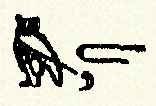
r by

(a mouth) and the comma

and the hieroglyph

i by two reeds

and two oblique strokes,

and s by

This gives us Meris, the name of that deposed
and fugitive king of Egypt who, after a last raid on the summer
palace of Mer-Shen, usurping ruler of Egypt, was followed and tracked
to Saïs, where, with an arrow through his back, he crawled
to El Teb and finally died there of his wound. All this Egyptologists
are perfectly familiar with in the translations of the boastful
tablets and inscriptions erected near Saïs by Mer-Shen, the
three hundred and twelfth sovereign after Queen Nitocris."
He looked
up at Burke, smiling. "Therefore," he said, "this
papyrus scroll was written by Meris, ex-king, a speculative thousands
of years before Christ. And it begins: 'I, Meris the King.'"
"How
does all this bear upon what concerns me?" demanded Burke.
"Wait!"
Something
in the quiet significance of the Tracer's brief command sent a curious
thrill through the younger man. He leaned stiffly forward, studying
the scroll, every faculty concentrated on the symbol which the Tracer
had now touched with the carefully sharpened point of his pencil:

"That," said Mr. Keen, "is
the ancient Egyptian word for 'little,' 'Ket.' The next, below,
written in two lines, is 'Samaris,' a proper name—the name
of a woman. Under that, again, is the symbol for the number 18;
the decimal sign,

and eight vertical strokes,
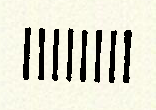
Under that, again, is a hieroglyph of another
sort, an ideograph representing a girl with a harp; and, beneath
that, the symbol which always represented a dancing girl
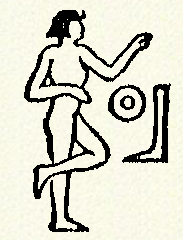
and also the royal symbol inclosed in a
cartouch,
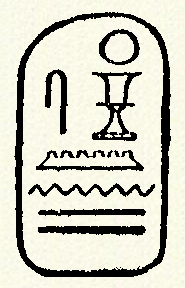
which means literally 'the Ruler of Upper
and Lower Egypt.' Under that is the significant symbol
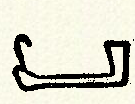
representing an arm and a hand holding a
stick. This always means force—to take forcibly or to use
violence. Therefore, so far, we have the following literal translation:
'I, Meris the King, little Samaris, eighteen, a harpist, dancing
girl, the Ruler of Upper and Lower Egypt, to take by violence—'"
"What
does that make?" broke in Burke impatiently.
"Wait!
Wait until we have translated everything literally. And, Mr. Burke,
it might make it easier for us both if you would remember that I
have had the pleasure of deciphering many hundreds of papyri before
you had ever heard that there were such things."
"I beg
your pardon," said the young man in a low voice.
"I beg
yours for my impatience," said the Tracer pleasantly. "This
deciphering always did affect my nerves and shorten my temper. And,
no doubt, it is quite as hard on you. Shall we go on, Mr. Burke?"
"If
you please, Mr. Keen."
So the Tracer
laid his pencil point on the next symbol
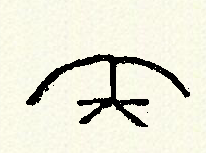
"That is the symbol for night,"
he said; "and that

is the water symbol again, as you know;
and that
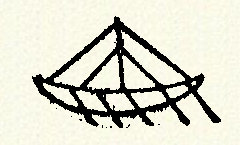
is the ideograph, meaning a ship. The five
reversed crescents

record the number of days voyage; the sign
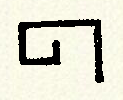
means a house, and is also the letter H
in the Egyptian alphabet.
"Under
it, again, we have a repetition of the first symbol meaning I, and
a repetition of the second symbol, meaning 'Meris, the King.' Then,
below that cartouch, comes a new symbol,

which is the feminine personal pronoun,
sentus, meaning 'she'; and the first column is completed with the
symbol for the ancient Egyptian verb, nehes, 'to awake,'
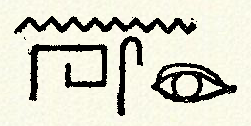
"And now we take the second column,
which begins with the jackal ideograph expressing slyness or cleverness.
Under it is the hieroglyph meaning 'to run away,' 'to escape.' And
under that, Mr. Burke, is one of the rarest of all Egyptian symbols;
a symbol seldom seen on stone or papyrus,

except in rare references to the mysteries
of Isis. The meaning of it, so long in dispute, has finally been
practically determined through a new discovery in the cuneiform
inscriptions. It is the symbol of two hands holding two closed eyes;
and it signifies power."
"You
mean that those ancients understood hypnotism?" asked Burke,
astonished.
"Evidently
their priests did; evidently hypnotism was understood and employed
in certain mysteries. And there is the symbol of it; and under it
the hieroglyphs
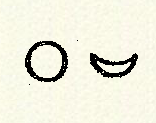
meaning 'a day and a night,' with
the symbol
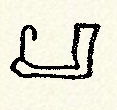
as usual
present to signify force or strength employed. Under that, again,
is a human figure stretched upon a typical Egyptian couch. And now,
Mr. Burke, note carefully three modifying signs: first, that it
is a couch or bed on which the figure is stretched, not the funeral
couch, not the embalming slab; second, there is no mummy mask covering
the face, and no mummy case covering the body; third, that under
the recumbent figure is pictured an open mouth, not a closed one.
"All
these modify the ideograph, apparently representing death. But the
sleep symbol is not present. Therefore it is a sound inference that
all this simply confirms the symbol of hypnotism."
Burke, intensely
absorbed, stared steadily at the scroll.
"Now,"
continued Mr. Keen, "we note the symbol of force again, always
present; and, continuing horizontally, a cartouch quite empty except
for the midday sun. That is simply translated; the midday sun illuminates
nothing. Meris, deposed, is king only in name; and the sun no longer
shines on him as 'Ruler of Upper and Lower Egypt.' Under that despairing
symbol, 'King of Nothing,' we have

the phonetics which spell sha,
the word for garden. And, just beyond this, horizontally, the modifying
ideograph meaning 'a water garden';
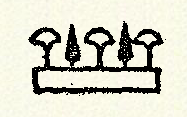
a design
of lotus and tree alternating on a terrace. Under that is the symbol
for the word 'aneb,'

a 'wall.'
Beyond that, horizontally, is the symbol for 'house.' It should
be placed under the wall symbol, but the Egyptians were very apt
to fill up spaces instead of continuing their vertical columns.
Now, beneath, we find the imperative command

'arise!'
And the Egyptian personal pronoun 'entuten,'
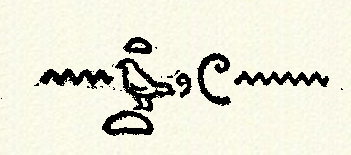
which
means 'you' or 'thou.'
"Under
that is the symbol
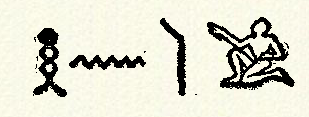
which
means 'priest,' or, literally, 'priest man.' Then comes the imperative
'awake to life!'
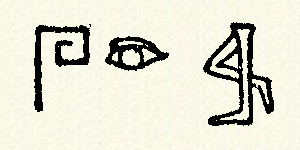
After that, our first symbol again, meaning
'I,' followed horizontally by the symbol

signifying
'to go.'
"Then
comes a very important drawing—you see?—the picture
of a man with a jackal's head, not a dog's head. It is not accompanied
by the phonetic in a cartouch, as it should be. Probably the writer
was in desperate haste at the end. But, nevertheless, it is easy
to translate that symbol of the man with a jackal's head. It is
a picture of the Egyptian god, Anubis, who was supposed to linger
at the side of the dying to conduct their souls. Anubis, the jackal-headed,
is the courier, the personal escort of departing souls. And this
is he.
"And
now the screed ends with the cry 'Pray for me!'
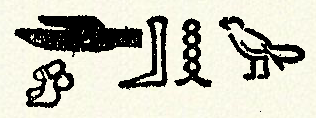
the last symbol on this strange
scroll—this missive written by a deposed, wounded, and dying
king to an unnamed priest. Here is the literal translation in columns:
I cunning
Meris the King escape
little hypnotize
Samaris
King of Nothing
eighteen place
forcibly
a harpist garden
a dancing girl—Ruler of water
garden
Upper
and Lower wall
Egypt
house
took forcibly—night Arise.
Do
by water Thou
five days Priest
Man
ship Awake
house To
life
I I
go
Meris the King Anubis
she Pray
awake
"And this is what that letter, thousands
of years old, means in this language of ours, hundreds of years
young: 'I, Meris the King, seized little Samaris, a harpist and
a dancing girl, eighteen years of age, belonging to the King of
Upper and Lower Egypt, and carried her away at night on shipboard—a
voyage of five days—to my house. I, Meris the King, lest she
lie awake watching cunningly for a chance to escape, hypnotized
her (or had her hypnotized) so that she lay like one dead or asleep,
but breathing, and I, King no longer of Upper and Lower Egypt, took
her and placed her in my house under the wall of the water garden.
Arise! therefore, O thou priest; (go) and awaken her to life. I
am dying (I go with Anubis!). Pray for me!'"